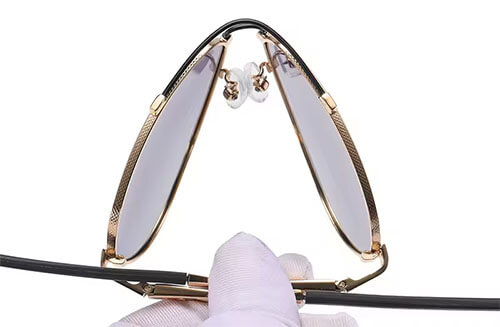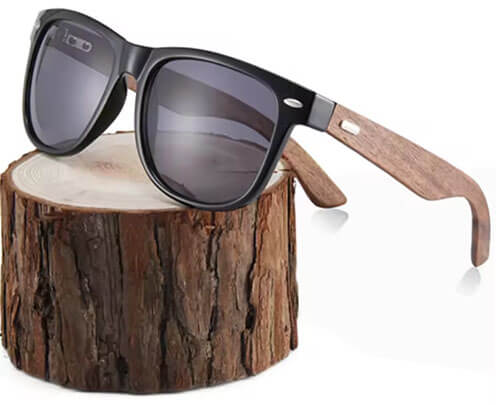Knowing about all the major sunglasses materials available in the market won’t only enhance your buying knowledge to get the right thing, but also grab more buyers’ attention from the seller’s point of view. So whatever your purpose is, this guide will help you understand and choose the ideal sunglasses according to their materials.
3 Main Types of Sunglasses Raw Materials
Sunglasses are just not the frames you see, but several components are used to make them. Similarly, different components are made from distinct materials. And depending on those, companies set the prices. So whether you’re going for an ordinary sunglasses product or opting for a brand, knowing about the sunglasses materials will always help you buy the right and durable product.
Mainly, there are three types of sunglasses materials used in manufacturing.
- Metal
- Plastic
- Natural
While the metal and plastic materials are traditional, natural material of sunglasses have caught the attention not very long ago.
7 Metal Sunglasses Materials
1. Stainless Steel
The stainless steel sunglasses materials are durable, strong, corrosion-resistant, and lightweight. Sunglasses frames with stainless steel material are inexpensive and can also be found in polished or matte finishes.

- Advantages
- They are durable
- Available in a variety of sizes
- Corrosion, weather, insects, and fire-resistant
- Disdvantages
- They are durable
- Available in a variety of sizes
- Corrosion, weather, insects, and fire-resistant
2. Memory Metal
Memory metal is basically titanium alloy made with 50% titanium and 50% nickel. Sunglasses with memory metal are pretty flexible, as they are capable of returning to their original shape. Thanks to the memory metal material for doing such wonders.
This material is a good choice when it’s about buying sunglasses for kids. However, this material is also popular among adults for everyday use.

- Advantages
- It can resist twists and bends and comes back to its original state
- Have more life as compared to stainless steel materials
- Disdvantages
- It’s a bit expensive material
3. Titanium
Titanium is a top-quality sunglasses material with high-level corrosion resistance. These materials are lightweight and also hypoallergenic.
- Advantages
- Very comfortable in wearing
- Ideal for making sports sunglasses
- It does not require heavy maintenance
- Skin-friendly, causing no harm to the skin if worn for several hours
- Disdvantages
- Expensive material
4. Beta Titanium
Beta titanium is a combination of alloy titanium mixed with small percentages of vanadium and aluminum. These sunglasses materials are usually more flexible.
- Advantages
- High flexibility
- Affordable sunglasses
- Easy to fit and adjust
- Disdvantages
- It does not have hypoallergenic properties as it lacks pure titanium
5. Beryllium
If you’re looking for an economical replacement for pure titanium, then you can go for the beryllium sunglasses material. This raw material resists tarnishing and corrosion, making it a superb choice for people with skin acidity issues.
- Advantages
- Economical price
- Hard to break
- Flexible and lightweight
- Excellent for wearers who spend most of their tie near salt and water
- Disdvantages
- This sunglasses material is not completely hypoallergenic – trigger allergies to beryllium-sensitive people
6. Monel
Sunglasses made with monel are surely inexpensive, as the material is the outcome of copper and nickel mixture. That’s why such sunglasses are lightweight and available in different price ranges due to the plating quality.
- Advantages
- Strong material that can be easily brazed, soldered, and welded
- Disdvantages
- The discoloration is common when exposed to ordinary atmospheric conditions
- Pitting is commonly found when exposed to saltwater
- This material causes skin allergies over time
7. Aluminum
Aluminum is one of the best sunglasses materials in terms of weight, strength, and durability. Sunglasses made of this material are lightweight and also have high corrosion resistance.
- Advantages
- It does not cause allergies
- Inexpensive and long-lasting even for years
- Disdvantages
- Does not resist rough handling
5 Plastic Sunglasses Materials
1. Nylon
Nylon sunglasses materials are strong, flexible, and lightweight. It is a popular material for making sunglasses lenses. However, nylon glasses become extremely fragile over time.
- Advantages
- Long-lasting and resistant to cold and heat
- The material is also best for sportswear
- Disdvantages
- Wearers sometimes feel unnatural and stiff
- This material does not come in a wide color range
2. TR90
TR90 comes from the nylon family. However, it is produced using Swiss technology and is a thermoplastic material. The TR90 sunglasses materials are extraordinarily lightweight on the face, and they also consist of the “Memory Frame Technology.”
- Advantages
- The TR90 material come back to its original shape if slightly disfigured
- Economical in price
- Disdvantages
- Durability fades away with time
- Not suitable for all skin conditions
3. Acetate
Acetate is a semi-synthetic material, which is why it is also called “cellulose acetate” or “Zyl.” The main ingredients of acetate are resourced from plant-based materials (cotton and wood pulp), and then turned into plastic sheets.
In other words, acetate material is a type of top-notch quality plastic made with renewable resources. The sunglasses made with this material comes in a variety of shapes and colors. Also, it is a widely-used material in designer sunglasses.
- Advantages
- Made from organic substances
- This material adjust and fits easily
- Available in full-depth designs and colors (no chemical paints are used)
- Have hypoallergenic properties
- Long-lasting and lightweight
- Disdvantages
- Extremely expensive as compared to other plastic sunglasses material
- Not suitable for sports activities
4. Polyamide
Polyamide is obtained from petroleum-based plastics, and it falls in the synthetic polymer category. Sunglasses materials made from polyamide are less brittle.
- Advantages
- Polyamide is crack-resistant
- It is an inexpensive material
- Disdvantages
- The material breaks under severe pressure
- Not suitable for sports activities
5. Polycarbonate
Polycarbonate sunglasses material is a group of thermoplastic polymers comprised of carbonate chemical structures. The material is not much reliable, which is why it is available at low prices.
Moreover, it has no durability, especially in the hot weather, which is why it easily breaks in the summertime.
- Advantages
- Highly cheap material
- Lightweight
- Disdvantages
- No durability
- Hard to fit and adjust
2 Natural Sunglasses Materials
1. Wood
The wooden sunglasses material is obtained from different kinds of wood – starting from the finest pines (coniferous wood) to ordinary hickory wood. This material is pretty reliable and long-lasting.

- Advantages
- Made with pure natural resource
- It gives a different look to the wearer
- Environmental-friendly
- Hypoallergenic nature
- It fits easily and is difficult to break
- Disdvantages
- Wood sunglasses material is expensive
- Available in limited patterns
- A bit heavyweight with no flexibility
2. Natural Horn
Natural horn sunglasses materials come from the water buffalo horns. The material is rare and supremely costly.
- Advantages
- Very gentle material and smooth on the skin
- Durable and fits good
- Disdvantages
- Expensive material
- Fragile under pressure
- Limited demand (hurt sentiments of vegetarian wearers)
If you are interested in more sunglasses knowledge and supplier information, welcome to check our other post:
Frequently Asked Questions about Sunglasses Materials
1. Plastic vs. metal eyeglass frames – what is best to choose?
It depends on your preference. If corrosion worries you and you want to feel light on your nose, then choosing plastic frames is a good thought. Contrarily, if durability matters to you and price is not a problem, then metal frames could be your pick.
2. What if my sunglasses get wet?
Currently, many sunglasses are protected with waterproof wax, saving the frame and other parts of the sunglasses from corrosion. However, it also depends on the sunglasses’ material. Plastic sunglasses survives the most when they come in contact with water. In comparison, some metal and wood frames are badly affected.
3. Does all sunglasses offer UV protection?
No. Not all sunglasses are made to protect you from ultraviolet rays.
4. Do wood sunglasses frame materials float?
The wood sunglasses frame materials do float on the water if they are protected with a wood wax finish
5. How to care for your sunglasses?
Whatever sunglasses material you have, make sure you don’t bend them intentionally, clear the dust using a soft fabric, preferably a microfiber cloth, and always keep them in their case when not wearing.
Final Words:
We hope this article can pass you some useful information about sunglasses materials. If you have any further questions regarding sunglasses after reading this, please leave a comment below.
We are Jingsourcing, a leading sourcing agency based in Yiwu China. We have been dedicated to helping business owners import all kinds of products, including sunglasses, from China at competitive prices. If you need help in importing sunglasses or other products from China, please don’t hesitate to CONTACT US.

Leave A Comment